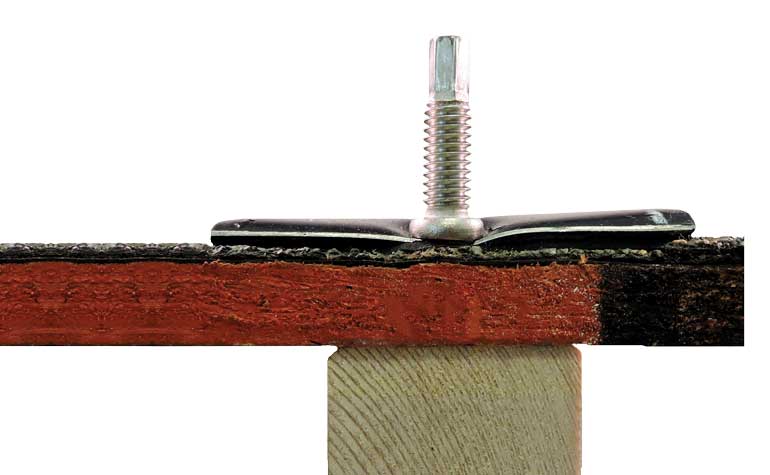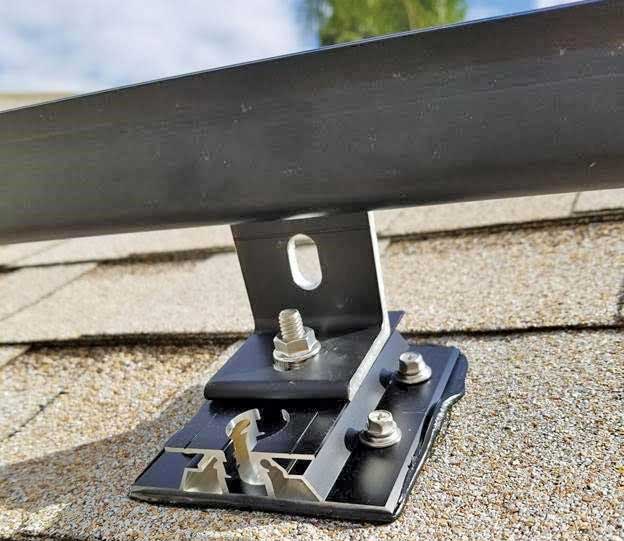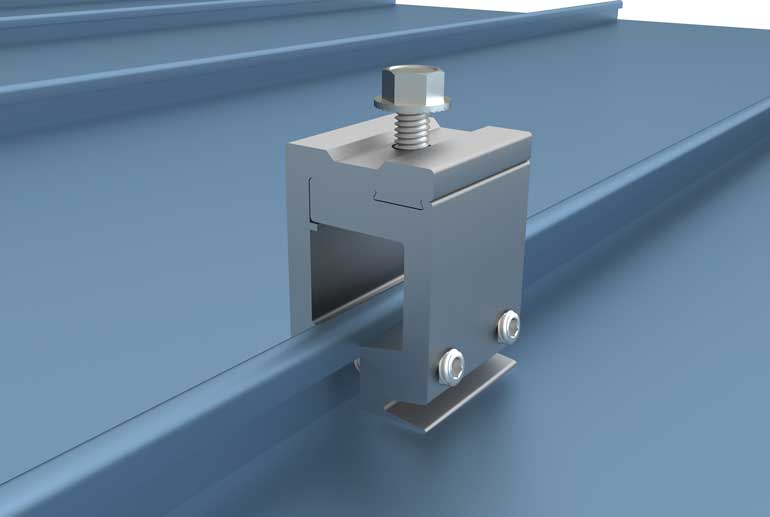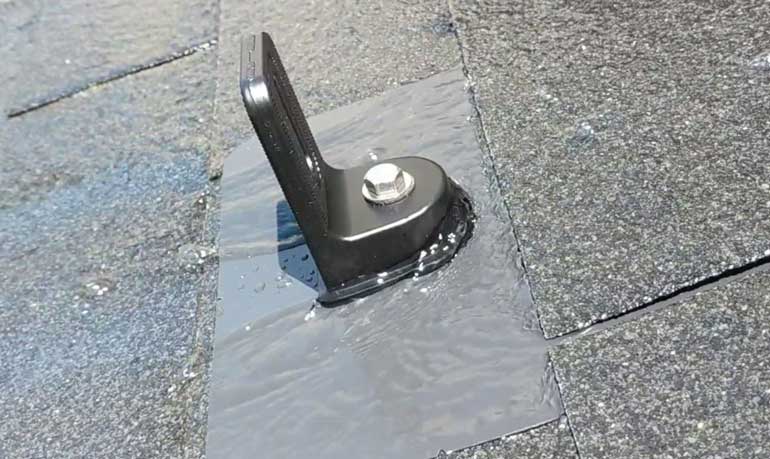
Solar installers face jobsite annoyances every day. Awkward roof space. Plastic baggies of tiny components. Missed rafters. And so on. Death by a thousand racking cuts. Luckily, for all of these situations, there is a mounting solution out there to make your life easier.
Micro but Mighty
It’s not the size of the flashing that counts, but the system that comes with it

QuickBOLT is a cool new name and logo, with a newly registered trademark for its solar mounting product innovation, but don’t be fooled: all of it is tied to a company and system you already know with decades of roofing and solar experience. Yes, formerly known as SolarRoofHook, QuickBOLT is the solar wing of Quickscrews International Corp., and its one of a kind Microflashing system is a component of its QuickBOLT and Low Profile QuickBOLT Mounting Kits.
The QuickBOLT is the world’s first and only UL Certified Microflashing mounting system, which seals roof penetrations and can be installed without lifting shingles or removing nails and staples. The QuickBOLT with Microflashing has been installed over 600,000 times with zero leaks.
With its new branding and new trademark in hand, we thought it was time we reintroduce you to the company’s strategy and how its system works.
Situation
Holes must be made in the roof for a solar installer to mount an array. Those holes must be sealed in some manner, otherwise the roof will leak. An installer who doesn’t use flashing methods greatly increases their risk of a leaky roof. Plus, International Building Codes require flashing to be used on residential rooftop solar. Flashing is typically sold as part of the mounting system. Mounting manufacturers design flashing products that, first and foremost, prevent leaks. Factors like ease of use or install speed more often come second.
QuickBOLT’s goal from the outset was to improve upon the various flashing methods out there with a flashing product design that would prevent water from entering the penetration while reducing the installer’s time up on the roof.
Key Considerations
In the late 2000s, minor innovations in flashing technology took place as mounting manufacturers began shifting away from “standoff” type mounts and toward mounts that integrated traditional flashing into the design. Both rubber bushed flashing and elevated flashing were became designs which added an extra layer of security to protect against water entering the penetration.
“30 years ago, Installers were mounting L-Feet directly to the roof with sealant alone,” says Jared Wiener, executive vice president at QuickBOLT. “In efforts to reduce leaks, the solar industry adopted flashing products that were more effective at redirecting water away from the hole—but often at the expense of voiding the roof warranty.”
Most of the flashing products used in the past included 12 in. x 12 in. pieces of metal to cover a hole that is typically only 5/16-in. in diameter. Installers ended up cutting the material to fit according to their array or simply to remove excess metal. Industry “best practices” were to lift up the shingles and place the flashing product underneath the 3rd course or layer.
The idea was that even though material and labor costs increased, these flashing products would prevent water from entering a penetration. But leaks still happened. Solar installers were unknowingly voiding roof warranties to install solar, becoming responsible for repairing leaks they could have prevented.
“We spoke with installers and roofers around the U.S. and learned that if we could eliminate the need to lift shingles, then solar installers could save a minimum of 30% of the time it takes for a typical solar install job,” Wiener said. “By providing installers with Microflashing, we were able to find the sweet spot between the simple L-Foot 30 years ago and the expensive flashing products of the 2000s.”
Solution: Microflashing
The patented QuickBOLT Mounting System debuted in 2010 for asphalt shingle roofs, which includes what is now properly known as Microflashing. The design of the system addressed the problems installers were facing: voiding the roof warranty by lifting shingles, speed of install, and reducing costs.
The QuickBOLT Kit consists of just three components: a custom hangar bolt, Microflashing, and a flange nut. When installers drive the bolt down, the collar compresses the Microflashing onto the roof, closing the penetration and creating a watertight seal. Any racking system can then be mounted by connecting a any type of bolt to the L-Foot. Installers have fewer components to carry onto the roof and can install the system in less than 60 seconds. The Microflashing is large enough to cover any other holes that might be made from missing the rafters, but unlike traditional flashing methods, installers no longer have to pay for extra, unused material.
What separates Microflashing from previous flashing methods is its placement. Before, installers would lift up the shingles and slide in the flashing underneath. Not only is this time consuming, but it potentially voids the roof warranty and increases the installer’s risk. Instead, Microflashing is designed to be placed directly over the shingle. Water is redirected around the washer just like other flashing methods — but it is significantly easier for installers to use and completely closes the penetration.
This innovation in flashing methods has given installers a new way to install more solar and increase profits.
Notes: QuickBOLT Patent #8448407. Microflashing is a registered trademark. © Copyright 2019. All Rights reserved Quickscrews International Corporation.
Situation
Transporting, cutting and maneuvering the mounting rails will be cumbersome.
Key consideration: Where and how to place solar mounting rails on residential rooftops.
Solution: The POWER DISK from Preformed Line Products (PLP) is a solar mounting system that can be placed anywhere on residential rooftops and does not need to be secured to rafters. Featuring a rail-less design, easy height adjustment and integrated grounding, the POWER DISK is a simple yet cost-effective solution for residential solar applications. What sets this mounting system apart is the roof deck mounting feature which allows for an easier array layout and faster PV module placement. The roof grip fasteners, sealing washers and pre-applied butyl mwastic are all included to provide a secure and reliable roof attachment. The benefits of POWER DISK:
- Flexible. Modules can be set in portrait or landscape format
- Adaptable. Attach anywhere on the roof
- Compatible. Fits most framed 60- and 72-cell modules
- Quick installation. Comes pre-assembled
- Built-in electrical grounding. Grounding clips are integrated in the mount
Situation
Steep roof and a large system, a solar array highly visible from home’s primary gathering place.
Key considerations
- Maximum fit on roof, same part count in landscape or portrait
- Low part count for easy and safe installation
- Exceptional aesthetics from any angle
Solution: Use a safe, fast rail-less solution that eliminates handling 20-ft rails on a steep roof and enables no-reach, module drop-in. Ecolibrium’s EcoX Universal Rail-Less Racking eliminates the need for 20-ft rails and the cost, risks and unsightliness of rails. The EcoX reduces attachments needed by 33 percent and uses 65 percent less aluminum to secure the array. Its no-reach-over panel drop-in design is a key feature, particularly on steep roofs. Components are universal to fit any module frame size, which allows installation to continue even if the module is changed. The design is flexible, resulting in a portrait orientation that fits the roof beautifully. A low-profile, finished look provides exceptional aesthetics for the highly visible location. Cost-per-watt is low.
Situation
Solar roof mounts for a standard composition shingle roof in Greenwich, Conn.
Key consideration: It’s a typical 35° snowy Mid-March day complicating jobsite conditions, so installers want to move quick.
Solution: The simplicity of Ecofasten’s RockIt system allows the installation team to complete the nearly 12-kW project in 7 hours, enabling installers to escape the bitter weather conditions in as short a time as possible. RockIt has a one-tool approach and only six components, much fewer than typical rooftop mounting systems. Furthermore, the rail-less RockIt solution allows for fewer roof penetrations compared with a rail-based system, further cutting down installation time and product parts. The installation team comments that they were able to bring all materials up to the roof quickly, with products being packaged in small boxes.
Situation
A 7-kW PV system installed on a regular comp shingle roof, 18-degree pitch with 24-in. OC rafter spacing. Twenty-four REC 295 modules at three rows of eight modules. Due to zoning and maximum rail spans, there are 30 roof attachments.
Key consideration: Time on and off is a priority as the crew is required to complete two jobs per day.
Solution: The SnapNrack Ultra Rail System’s snap-in strategy is featured throughout the installation process — from the the snap-in Ultra Rail Mounts to the module clamps to the wire management accessories. The lightweight rail and pre-assembled components allow for easy transportation on and off the roof. All components are installed with a single tool, a ½-in. socket, eliminating the need for more parts and pieces on the roof. An installation team of four can install this 7-kW system in less than 4 hours, allowing them to get two jobs done and still get home in time for dinner with the family.
Situation
A typical existing asphalt roof for a retrofit PV installation.

Key consideration: The installer wants to secure the mounting system to the roof without having to undo the existing seal of the roof shingles or affect the roof warranty.
Solution: Because of its simplicity and the ICC-certified “flexible flashing” system, the Roof Tech MINI is fastened to the roof without the need to damage the seal of the existing shingles. This approach does not impose a damage of the underlayment nor does it require the removal of nails needed to secure the asphalt shingle roofing. By comparison, installing a traditional metal flashing system on an existing asphalt roof requires the breaking of the seal between shingles and can cause additional damage to the underlayment through scratching it with the metal flange. Also, the opening of a hole on the underlayment from pulling an existing nail used to secure the shingles above in order to slide the upper metal flange into the third course also poses another quality issue. RoofTech says it avoids violating the roof warranty while allowing for a quicker installation time. Additional time is saved in comparison to lag bolts, due to the use of wood screws which don’t need a pilot hole.
Situation
A homeowner getting an asphalt shingle roof replacement requests a quote for solar but express minimal interest in rack and panel systems feeling it’s a ‘dated’ look.
Key consideration: Losing this sale by only offering traditional rack and panel solar.
Solution: The Apollo II solar roofing systems from CertainTeed are engineered for seamless integration with new or existing asphalt shingle roofs. Each all-black solar shingle offers 63 watts of rated power, and at 1.22 in. thick, provides a sleek, low-profile aesthetic. Apollo II solar shingles attach directly to the roof sheathing with standard deck screws, feature a concealed wiring design and can be installed in any wind zone (including Florida’s high velocity hurricane zone). Dynamic flashing allows for flexibility in rooftop system layout, with water channels and raised fastener locations providing superior protection against water intrusion.
Situation
A small 17-kW commercial job at Canterland Farms near the Yamhill-Carlton American Viticultural Area in Oregon.

Key consideration: It can be a challenge for installers to fasten standing seam clamps onto the roof seams because many clamps have attachment screws that are too close to the flat roof surface.
Solution: SunModo’s 1-in. EZ Standing Seam Clamps can be attached to a wide variety of seam profiles. The EZ Standing Seam Clamps use set-screws to compress the seam material against the opposite wall of the clamp. The preassembled set-screws can be attached on the vertical leg of the clamp or on the adjacent leg with its 10-degree angle and hook for greater gripping. The clamps are super easy to install, and the upward angle of the set-screws leaves plenty of work space between the drill and the roof. The oval end set-screws and proper torque ensures the protective coating of the roof seam is not damaged during installation.
SunModo also offers 2-in. EZ Standing Seam Clamps which can be installed in-situ at the desired seam attachment location. These clamps are a two-part assembly and uses the same upward angled set-screws to secure them firmly to the roof; no more sliding clamps up the roof line.
Situation
Sloped metal roof on residential and commercial buildings are mostly standing seam, R-Panel trapezoidal and corrugated metal roofs, but due to different profiles from different manufacturers, there are various brackets available for solar installations.
Key consideration: Save time wasted by checking out each roof profile and settle on only one or a few brackets that fit most of the metal roofs.
Solution: The MageBracket R has an angle-adjustable bracket that fits most of the popular R-panel trapezoidal metal roofs. The bracket has two adjustable parts that can rotate to fit the rib with different angles. Therefore, installers don’t need to check out the roof profile first, then look for the right bracket and then wait for the bracket to arrive. Instead, they can stock just one bracket to save money and time. Similarly, MageBracket CH is also an angle-adjustable bracket that fits most corrugated metal roofs with rotating parts for different angles. For low-profile corrugated metal roofs of only 1/4 in. to 1/2 in. tall, MageBracket CL is width-adjustable and fits most low-profile corrugated metal roofs.
Situation
Installer is struggling to find structural members. They are drilling enough probing holes to infer center from a series of hits and misses. Stud finders cannot read through layers of roofing material and plywood and other high-tech devices have given mixed results.
Key consideration: Locating rafters without creating more penetrations than are needed to install the PV system.
Solution: Tucson-based RafterEye LLC just launched Clampster, a rafter center locating tool, to assist PV installers and others in rooftop attachments. Clampster — which can be used in a variety of construction applications such as exposed beams, porches, navigable attics, skip sheathing, log rafters — works through any roof type except steel. The clamp portion of Clampster grips the rafter just below the deck, and it works by forming a magnetic field around and through a rafter or truss. A rooftop worker reads the magnetic field, which points precisely to rafter center before any penetrations are made. The magnetic field can be read through up to 6 in. of insulating material that may be present (above or below the roof deck) between the available portion of the rafter and the roof membrane. There is no need to infer from one or both edges. Workers move rapidly, precisely locating one attachment point after another before any penetrations are made.
Situation
A rooftop that’s not quite near replacement but getting there. Homeowner wants a solar system now, but also wants to avoid the hassle of removing/reinstalling at replacement time.
Key consideration: This is a home in the Northeast, which is notorious for rocky soil.
Solution: APA Solar Racking has a Pre-Engineered Kit that’s a concrete-free solution for project sizes under 150 kW. This system is custom to any two panel increments. It comes with every part necessary for the racking, and 10 kW can be installed in 4 hours with a skid steer and auger attachment. In lieu of concrete, APA offers three types of foundations: helical anchor, geoballast and ground screw. A ground screw is best used in rocky soils, whereas a helical is ideal for soft organic soils. A geoballast is used when the soil is non penetrative.
Situation
A farm with high electric load and a 15-kW AC capacity cap in place. There is a time-of-use (TOU) rate schedule in place from the utility, with the higher rate between 4 p.m. to 7 p.m. There is an open view of the sky E,S,W.
![]()
Key consideration: The roof is not great from a structural or orientation perspective, and a ground-based solution should make best use of land.
Solution: The AllEarth Solar Tracker is a grid-tied, dual-axis solar tracker ideal for both commercial and residential settings to take advantage of the sky E,S,W to get maximum production. Here, there would be minimal if any shading from buildings, trees, etc. due to the open farm field. Any permit limitations with an AC limit (vs. DC) will be an advantage for this tracker which produces more power (kWh/kW). The tracker system can be sized to that 15-kW cap and produce up to 45 percent more energy than a similarly sized fixed-tilt system. All of this takes up less room compared to fixed, helping the farmer get the most yield from their land. Under and between the trackers is still usable land for most agricultural needs. Due to the increased afternoon/evening production of the tracker, more kWhs are produced during the TOU, which best offsets costs.
Situation
A new crew member is on a presidential shingle roof installing flashings and L-feet. He rips open a plastic bag containing EPDM washers for the lag screws, and several fly out, rolling off the roof. He then places a flashing over the uneven presidential shingle tabs and installs the lag with an impact driver.

Key consideration: Quality control. When installing on un-even shingle tabs, such as presidential shingles, 1) press-fit flashings can crack at the water seal; 2) flashings with deck-level water seals may not seat fully against the L-foot, and 3) adhesive reliant flashings may not seal to the shingles around the roof penetration. All of these scenarios have leak potential.
Solution: Pegasus’ Comp Mount has several features to ensure high-quality, lasting and consistent installations. The All-In-One kit packaging has no plastic bags and includes all flashings, L-feet, lags and EPDM washers so there’s less chance of forgetting parts at the shop. The EPDM washers come pre-installed onto the lags to ensure they are installed every time and not lost in gutters. Pegasus’ Comp Flashing has a 0.7-in.-tall cone formed from a single piece of metal, meaning there are no deck-level washers or press-fit pieces to break and allow a roof leak. Pegasus’ L-foot elevates the water seal 0.9-in. above the roof surface, diverting much of the water flow. Finally, a bonded EPDM washer at the lag head acts as a final defense against water intrusion.
— Solar Builder magazine









Leave a Reply
You must be logged in to post a comment.